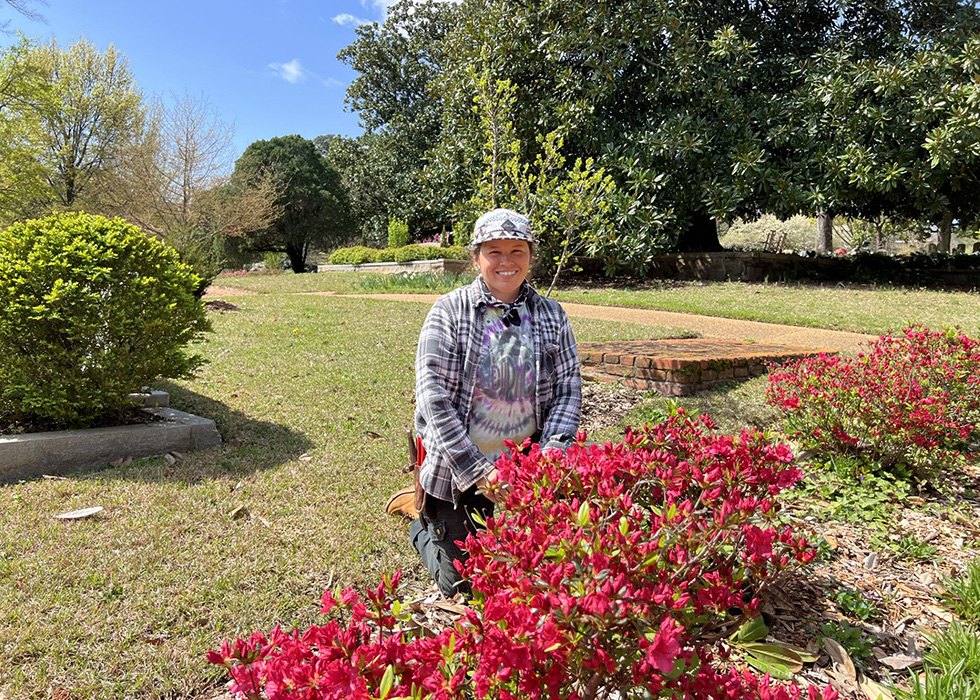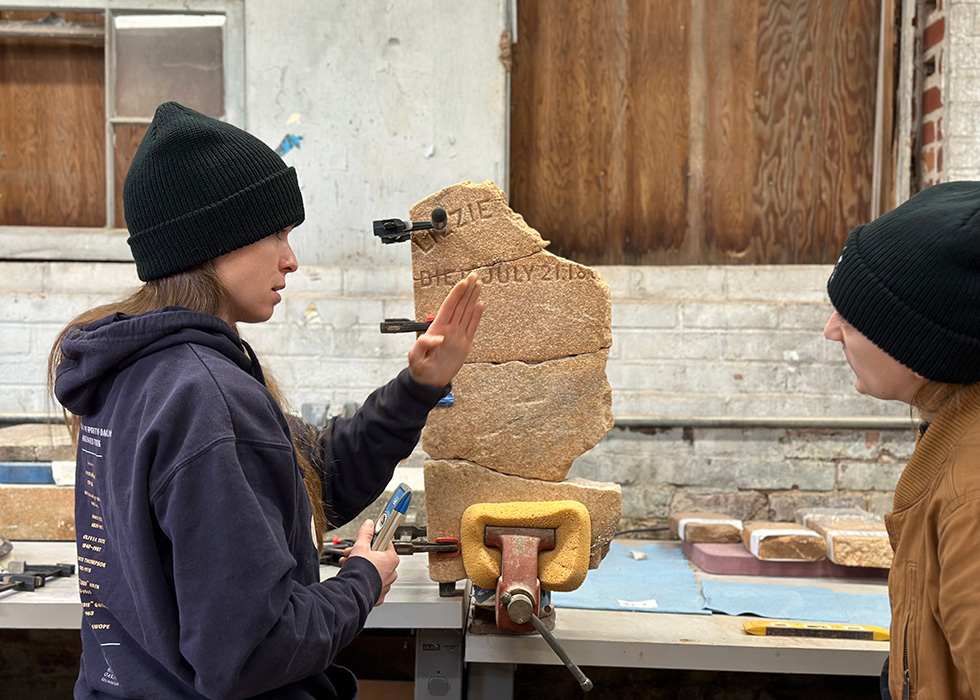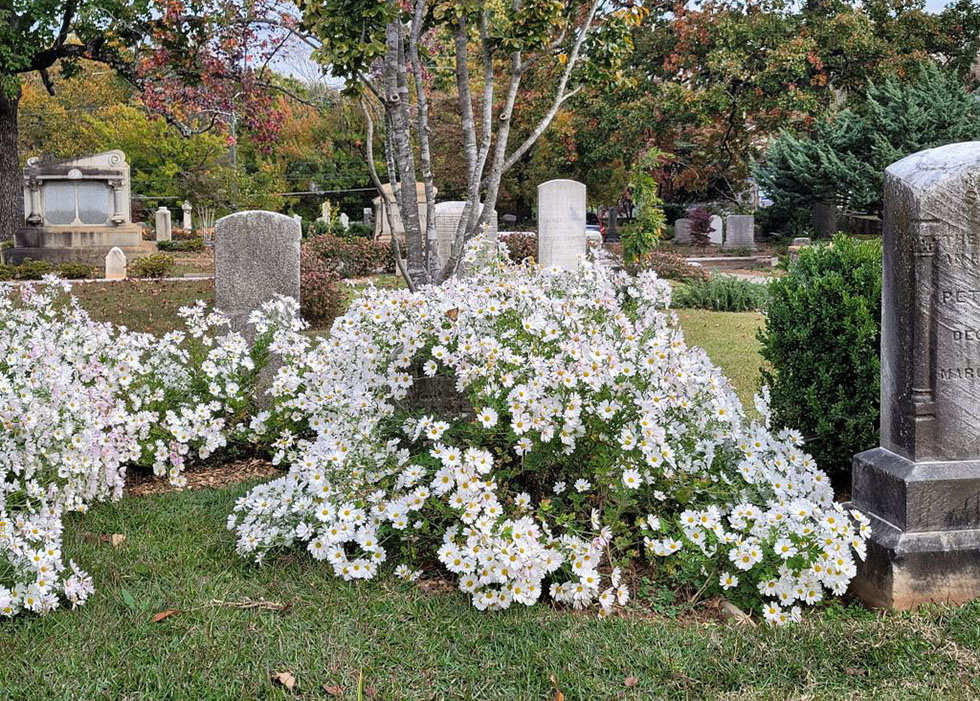
Early Landscapes: The Hedges and Shrubbery of Oakland
Little is known of Oakland’s horticultural landscape in its first two decades. Few Atlanta newspaper issues survive from the 1850s. Except for bemoaning the town’s destruction during the Battle of Atlanta, not many people wrote about the “City Grave Yard” in the 1850s or 1860s. Lastly, the City Council concerned itself solely with the administrative logistics of burial lot sales and issues of security. Yet among these brief and bureaucratic meeting minutes are mentions of plants, shrubs, and trees having been planted by Oakland’s families.
The Hedge Tradition
In the 1840s and 1850s, good taste in  cemetery horticultural ornamentation dictated hedges around the family lot. Hedges of evergreens were touted as an alternative to iron enclosures, which required regular painting and were more expensive (and some tastemakers just found them gloomy or downright distasteful). Recommended evergreens included boxwood, arborvitae, privet, and euonymus. The interior of the lot was to be graced with specimen shrubs, flowering perennials (preferably white-flowered) or ornamental trees artfully placed. The corner shrubs, and those flanking the lot entrance were traditionally taller and clipped into a pointed or rounded cone. These corner evergreens may have been a different variety than the rest of the hedge, providing foliage contrast as well as the desired height.
cemetery horticultural ornamentation dictated hedges around the family lot. Hedges of evergreens were touted as an alternative to iron enclosures, which required regular painting and were more expensive (and some tastemakers just found them gloomy or downright distasteful). Recommended evergreens included boxwood, arborvitae, privet, and euonymus. The interior of the lot was to be graced with specimen shrubs, flowering perennials (preferably white-flowered) or ornamental trees artfully placed. The corner shrubs, and those flanking the lot entrance were traditionally taller and clipped into a pointed or rounded cone. These corner evergreens may have been a different variety than the rest of the hedge, providing foliage contrast as well as the desired height.
The hedge tradition, encouraged by nursery trade, held on longer outside the major metropolitan areas of the country, until the widespread advent of the lawn design in the 1880s and 1890s. Southerners, in particular, were much slower to bend to the winds of new horticultural trends in the decades after the Civil War. Atlanta’s Westview Cemetery, established in 1884, was designed under the lawn aesthetic, its undulating sweeps of lawn judiciously accented with trees, evergreen shrubs, and roses.
 When the City expanded the cemetery in 1866 and early 1867, City Council’s Committee on Cemetery convinced the mayor and council to hire a professional landscape gardener to lay out the new paths and drives. Belgian immigrant Alphonse Lambert (whose Central Nursery was located where Tin Lizzy’s now stands) was one of Atlanta’s first landscape gardeners and was hired for the job the spring of 1867. In June 1869 John Connally was elected Sexton; his entry in the 1870 census reveals him as Irish and a gardener. By 1869 Lambert was advertising his business in landscape gardening of all sorts, including cemetery lots. With a gardener at the helm and a nurseryman literally across the street, the men set out to make the cemetery a showplace to the best of their abilities and the era of Oakland as a garden spot dawned.
When the City expanded the cemetery in 1866 and early 1867, City Council’s Committee on Cemetery convinced the mayor and council to hire a professional landscape gardener to lay out the new paths and drives. Belgian immigrant Alphonse Lambert (whose Central Nursery was located where Tin Lizzy’s now stands) was one of Atlanta’s first landscape gardeners and was hired for the job the spring of 1867. In June 1869 John Connally was elected Sexton; his entry in the 1870 census reveals him as Irish and a gardener. By 1869 Lambert was advertising his business in landscape gardening of all sorts, including cemetery lots. With a gardener at the helm and a nurseryman literally across the street, the men set out to make the cemetery a showplace to the best of their abilities and the era of Oakland as a garden spot dawned.
While nothing is known of Connally’s life as a professional gardener, his landscaping skills for bringing Oakland into a lovely garden spot quickly won him the praises of the Committee on Cemetery, family members and the visiting public. He set in motion a number of projects that guided later sextons and families to Oakland’s landscape’s benefit. The Ladies Memorial Association heralded Connally’s arrival at Oakland in The Constitution. They saw him as an ally and supporter of their memorialization and beautification efforts. Unsurprisingly, when the Ladies embarked on their first landscape project of the Confederate Grounds, they turned to Lambert and his nursery stock. In late 1870 Lambert sold the Ladies Memorial Association 500 arborvitae shrubs. He planted them and 1,250 euonymus plants the Ladies ordered from Augusta for a hedge encompassing the Confederate Burial Grounds in January 1871. However by 1888 the Ladies found the euonymus needed replacing and selected the more robust wax leaf ligustrum.
A New Sexton Continues the Work
 John Connally died in 1874, and his successor, L. Greene Holland, carried on his work. In 1875 Sexton Holland planted a euonymus hedge around the North Public Grounds, sowing the interior ground with bluegrass and fertilizing with guano. The same year Lambert advertised his evergreens as a variety of arborvitae, red cedar, cypress, and magnolia; for hedges, he offered euonymus, arborvitae, and boxwoods. In 1876 Sexton Holland planted a hedge of euonymus on either side of the main drive and principal walks in the Original Six Acres.
John Connally died in 1874, and his successor, L. Greene Holland, carried on his work. In 1875 Sexton Holland planted a euonymus hedge around the North Public Grounds, sowing the interior ground with bluegrass and fertilizing with guano. The same year Lambert advertised his evergreens as a variety of arborvitae, red cedar, cypress, and magnolia; for hedges, he offered euonymus, arborvitae, and boxwoods. In 1876 Sexton Holland planted a hedge of euonymus on either side of the main drive and principal walks in the Original Six Acres.
In 1880 Sexton Holland’s second phase of beautifying North Public Grounds was well received, as the Committee on Cemetery’s Annual Report for 1880 reveals:
“We find all the hedges etc., are kept neatly trimmed and in excellent order. In the public ground of the old portion of the cemetery, the sexton has placed an abundance of shrubbery which is now growing finely, thereby rendering the graves of the unknown poor (that has heretofore been a blot) to some excellent attractive. [sic]” It’s tempting to speculate the hedge plants and shrubbery came from Lambert’s nursery. It seems quite feasible that Sexton Holland maintained the relationship between the Oakland and Central Nursery that Sexton Connally supported.
As Oakland transformed from a ho-hum graveyard to a noted spot of beauty, professional photographers came to document the scenic views. These images illustrate the slow but steady progression of improvements, and how hedges and evergreens came to dominate many areas of Oakland’s landscape, from the 1870s to the mid-1890s, particularly closer to the original Sexton’s office (replaced by the Bell Tower in 1899).
A stylized engraving of the obelisk in the Confederate Grounds published in 1877 depicts intricate hedge patterns, neatly clipped into formal lines, with taller accent shrubs. Many annual reports to the City Council boast of the hedges being neatly trimmed, an obvious job performance comment for the fitness of the sexton executing his duties.
Images of Oakland
 The earliest dated image of Oakland found so far is an 1875 stereoview taken from just north of the Henson-Parris mausoleum, looking northwest towards what is now the MARTA parking lot. Seven years after the cemetery’s expansion, it is still a wild and weedy area, somewhat landscaped and not particularly mowed. Hedge plants and evergreens are present, even before many headstones; while some evergreens are kept in pyramidal forms, a number of hedge plants need trimming. The varying states of pruning make one wonder who was primarily responsible for landscape maintenance, the Sexton’s staff or the families.
The earliest dated image of Oakland found so far is an 1875 stereoview taken from just north of the Henson-Parris mausoleum, looking northwest towards what is now the MARTA parking lot. Seven years after the cemetery’s expansion, it is still a wild and weedy area, somewhat landscaped and not particularly mowed. Hedge plants and evergreens are present, even before many headstones; while some evergreens are kept in pyramidal forms, a number of hedge plants need trimming. The varying states of pruning make one wonder who was primarily responsible for landscape maintenance, the Sexton’s staff or the families.
A second stereoview dating to the early to mid-1880s showcases the neatly trimmed hedges so admired in the newspapers and City Council reports. Looking southeast towards the Sexton’s office with the Austell mausoleum in the distance, the foreground lots reveal “newer” hedges and shrubbery. Lots further away are graced with mature hedges meticulously clipped, accented by columnar evergreens placed at the lot corners and specimen shrubs in the middle of the lots.

A third image is an 1887 lithograph created from a photograph. Taken from the area behind the Sexton’s office, near the Richards mausoleum, looking west in one of the most desirable sections of the cemetery. It captures both a tastefully-landscaped lot with hedges and shrubbery in the foreground and the recently erected and ever imposing Cox monument in the distance.
A fourth image, thought to have been taken around 1893 to 1895, again showcases the desirable area northwest of the Sexton’s office. This view, looking northeast, documents the same area as the 1887 lithograph but captures a more mature landscape. Most of the hedges are boxwood, a relatively slow-growing plant that keeps its pruned shape longer than many other hedge plants. Southern magnolias of some size frame the towering Cox and Kiser monuments and Kiser mausoleum, and the flowering bush in the foreground is thought to be a spirea. A number of lots in this general area still have family-planted English and American boxwoods, though many plants are suffering greatly from old age.
By the close of the 1890s, with changing tastes in landscape design, one would expect to see fewer hedges in period photographs. Yet recently planted hedges appear in the eastern portion of the cemetery around 1898, with one lot’s hedge looking very much like rose bushes. Thus, some Oakland families continued to plant hedges at least along the main drives, providing a physical and psychological border between the public drive and the private burial space.
Hard Times for Hedges
It was not always an idyllic life for the Oakland hedges. The first ordinance issued for the cemetery in 1858 specifically prohibited anyone to, “cut break remove or injure any tree shrub or plant that may have been planted, or that may be growing in said Cemetery….” In May 1878 a petition was put before the City Council, “relative to the abuse of shrubbery in Oakland Cemetery by the employees.” The resolution was adopted, “to lay the complaint against the employees at the cemetery on the table.” The harsh winter of 1893-1894 killed large quantities of Oakland’s old shrubbery, requiring those lots to be “nicely shaped and protected,” presumably by planting turf grass, after the dead bushes were removed. But the biggest complaint against cemetery staff regarding abuse of Oakland’s hedges came in 1896, and the offender was the Sexton himself.
At first Sexton T.A. Clayton (1893-1896) won praises for his efficiency, good work, and new burial record-keeping system. But soon his corrupt ways came to the fore; City Council investigated him for a long list of professional transgressions and he was summarily dismissed. One suspects Clayton’s treatment of the hedges was high on the list of grievances:
“I find that he has destroyed a great many hedges and evergreens around private lots in the cemetery, and, in many instances, against the open protest of lot owners – leaving many lots perfectly barren. Why Clayton should assume to have the authority to destroy these hedges – a work of years by the lot owners for the love and remembrance they bore for their dead – is beyond reasonable conception.”
Ligustrum hedge plants are readily identified in many stereoviews, lithographs, and photographs from the 1870s to 1890s. While not a plant advertised by Lambert and his Central Nursery, the larger Rosehill Nursery on the west side of town advertised in The Constitution a much broader range of plants in December 1874. Shrubs included gardenias, mock orange, roses, spirea, deutzia, hydrangea; hedge plants included boxwood, althea (“Rose of Sharon”), euonymus and privet, and the wide array of evergreens included four varieties of arborvitae, three varieties of cypress, and varieties of junipers, firs, cedars, laurels, etc. M. Cole and Co., meanwhile in 1875, advertised oleanders for the lawn and a large assortment of fragrant shrubs including banana shrubs and tea olives. By 1882, Cole was touting his collection of cape jessamines (gardenias) as the largest in the South.
Family photographs not released for public use have been used to recreate original landscapes. These recreations, however, must weigh a number of factors and issues, such as installation costs, disease susceptibility, ease of care (such as trimming frequency), low chemical needs, and, for a modern setting, year-round interest. In some cases, an educated guess was made in replicating evergreens and hedge plants (in particular a lot just east of the Bell Tower in front of the Grant mausoleum), as trying to match leaf form and growth habit to plants in grainy photocopies is not facile. In another lot a bit of artistic license was used to substitute rather drab ligustrum – which needs frequent trimming to maintain its form –with a showier flowering sasanqua hedge (near the front porch of the Bell Tower, southwest of the Rawson mausoleum).
The wax leaf and curly leaf ligustrums are similarly used in many Foundation landscape projects. Numerous photographs of the 1888 wax leaf ligustrum hedges in the Confederate Burial Grounds guided the restoration of those hedges. However, restoration projects avoid euonymus as a hedge plant due to its immense size at maturity and its susceptibility to diseases. Instead, a number of single specimen euonymus plants have been added to the Oakland landscape over the years. Privet was used across the cemetery by families for hedges, and some of these still survive. But due to its highly invasive nature, plant varieties other than privet are now employed. Similarly, while boxwood has been used for hedges in numerous restored areas, due to environmental stressors the varieties of choice now are Korean cultivars, not the English and American varieties originally planted by families.
In the 1890s, families’ taste in landscape design shifted toward the newer lawn aesthetic, likely driven in part to the widespread loss of their old hedge plants. The hard lines of clipped hedges and trimmed specimen shrubbery yielded to more open designs and the use of low-growing perennials to soften the stonework. Hedges remained but were not nearly as prominent. Some new hedges were planted to define and secure the private family space from the public drive, while others enclosed the lot but were clipped much lower for a more open vista. These lost landscapes, fortuitously captured on film, serve to guide and inspire the re-beautification of Oakland today.



